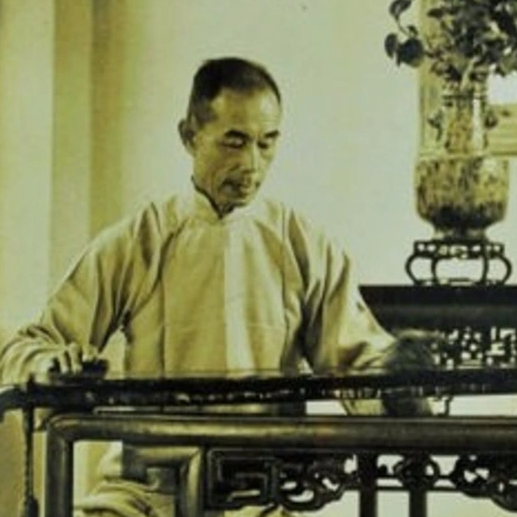Yang Xinlun

Yang Xinlun's grandfather, Yang Ruiyan, was the chief mate of the Haiyi warship belonging to Sa Bing of the Beiyang Navy. His father, Yang Bozhai, worked as a teacher in Shanghai in his early years and was proficient in rhythm. When Yang Xinlun was studying in Guangzhao Yixue, he was a classmate with Lv Wencheng, who later became the originator of Guangdong music, which had a certain impact on Yang Xinlun's lifelong guqin art career.
Yang Xinlun was born in Shanghai and has practiced martial arts since childhood. Yang Xinlun is a famous guqin player and a famous martial artist. He has served as a martial arts teacher in Shanghai Jingwu Sports Association (founded by Huo Yuanjia), Guangdong Kunwei Girls' Normal School, Jiangsu Zhenjiang Mincheng Middle School and other places. He and Huo Dongge, a famous martial artist, are members of the Jingwu Association and have learned boxing skills with each other. In the mid-1920s, by chance, Yang Xinlun listened to the performance of Wu Chunbai, a famous guqin master, at the Jingwu Society.
In 1928, Yang Xinlun bought a guqin at Qingmi Pavilion, Wende Road, Guangzhou, and went home to tune the strings. Wang Shaozhen is a native of Guangxi, known as Liyufeng native. Yang Xinlun learned "Xianweng Cao" and basic basic exercises from teacher Wang Shaozhen, and then got to know Lu Jiabing, Chen Shuju, Rong Xinyan, Tan Shaofu and other influential figures in the guqin world through Wang Shaozhen, and took Lu Jiabing as a teacher and learned from Lu Jiabing "The Fisherman's Questions and Answers" and other songs. Later, due to Lu Jiabing's family moving to Hong Kong, through Lu's introduction, Yang Xinlun found Zheng Jianhou, the authentic successor of Lingnan Guqin, and worshipped Zheng as his teacher for 20 years.
Yang Xinlun learned from Zheng Jianhou the classic guqin songs of the Lingnan School, such as "Bijian Liuquan", "Jade Tree in the Wind", "Nostalgic", "Ou Heron Forgetting the Machine", "Black Night Cry" and so on. With the efforts of today's Lingnan people, these classic songs will be passed down from generation to generation.
Yang Xinlun worked as a martial arts teacher in Zhenjiang Middle School and Guangdong Kunwei Girls' High School in his youth, and then worked in insurance in Guangdong, Shanghai, Tianjin, Shenyang and other places until he returned to Guangzhou in 1953 and joined the Guangdong Institute of Literature and History. After more than half a century of wandering, I concentrated on the research and teaching of Lingnan Guqin. In order to thank the country, he presented more than 20 precious guqins to the country, including the famous qin "Xiaoyue" (now in Shanghai Museum) collected by Ju Lian, the founder of the famous Lingnan School of Painting. Since this period, Yang has been absorbed into the Chinese Musicians Association, and accepted the commission of the Guangdong Musicians Association, and contacted the surviving old pianists Zhao Jianfen, Zhou Guijing, Sun Mutang (the father of Sun Leyi, Sun Leyi once served as the city of Guangzhou City) Chang) and others, gather together from time to time to learn about piano skills.
In 1959, Yang Xinlun attended the National "Congress of Culture and Literature" held in Beijing and was received by Chairman Mao. In September 1960, Yang Xinlun was employed in the Guqin major of the Folk Music Department of Guangzhou Music College. The apprentice students Xie Daoxiu and Guan Qingyao and the elective students Yang Shide and Liang Zhaorong sowed the seeds for Lingnan Guqin. In the first Yangcheng concert held in Guangzhou in 1962, Yang Xinlun led students Xie Daoxiu and Guan Qingyao to participate in the performance. The unison "Question and Answer of the Fisherman" was a success, and the Lingnan guqin entered the hall of elegance for the first time. In 1963, Mr. Yang Xinlun attended the first National Guqin Music Score Conference.
During the "Cultural Revolution", how many precious guqin were smashed or died in a sea of fire. Yang Xinlun has made unremitting efforts to protect the precious guqin and materials that have been collected for many years, so that they will not be damaged in the ten years of turmoil. After the "Cultural Revolution", Yang Xinlun convened students to discuss the plan to revive the Lingnan Guqin. At this time, Li Xiangting, a famous guqin player, came to Guangzhou to perform with the Chinese Song and Dance Troupe, causing a "guqin craze" in Guangzhou for a while. Yuan Jiancheng, Luo Qiaoling, Ou Junhong, and Zhong Jinzhang, who had studied boxing with Yang Xinlun, also learned guqin. Afterwards, Mr. Mo Shangde, Mr. Mo Zhongyu, Mr. Mai Hanxing, and Li Chunchan, Zhu Libing, Wan Meixia and others from the original literature and history night school revived the Lingnan guqin that had been sleeping for many years.
With the support of the Guangdong Musicians Association and the efforts of Mr. Yang Xinlun, the Guangdong Guqin Research Association was established on October 24, 1980, with Yang Xinlun as the chairman and Mo Shangde as the vice chairman. The establishment of the Guangdong Guqin Research Association marks that the Lingnan Guqin has entered a new era.
On February 1, 1990, on the sixth day of the Lunar New Year, Mr. Yang Xinlun, the master of Lingnan Guqin, passed away at the age of 92. Every year during the Qingming Festival, Yang Xinlun's disciples and grandchildren will go to the outskirts of Yang Xinlun's cemetery to worship with reverence. Yang Xinlun encouraged the new generation with his lifelong struggle for the inheritance and development of Lingnan Guqin.
Similar artist
Involving musical instruments
Involved portfolio
Involved news
Popular artists
- 01 Zhang Xiuyan
- 02 A Shicai
- 03 Zhang Gaoxiang
- 04 Zhu Changyao
- 05 Feng Yu
 渝公网安备 50010702504639号
渝公网安备 50010702504639号